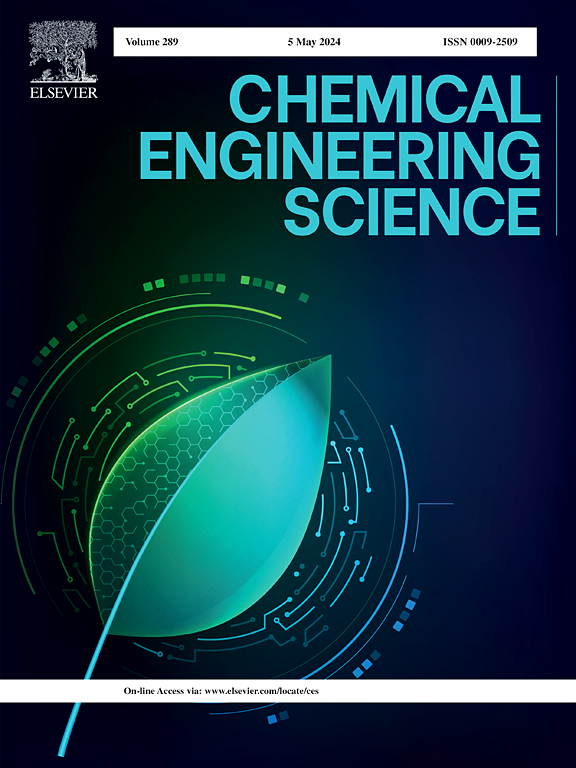蛋白质和表面活性剂对气液生物反应器中氧传质影响的实验研究
IF 4.3
2区 工程技术
Q2 ENGINEERING, CHEMICAL
引用次数: 0
摘要
本研究考察了乳清蛋白浓缩物、酪蛋白酸钠和Tween 20对低雷诺数和低体积气体流速搅拌槽反应器中气液传质的影响,这是厌氧系统中典型的流体动力条件。这些化合物普遍存在于生物介质中,显著影响液相的物理化学性质,进而影响传质效率。研究了在低搅拌雷诺数和表面气速条件下,这些化合物对液侧传质系数(kLkL)和气液界面面积的影响。结果表明,蛋白质和表面活性剂增加气含率,从而增加气液界面面积。与空气-水系统相比,蛋白质使界面面积增加了2到20倍,而Tween 20则超过了100倍。这种增强归因于Tween 20的快速吸附动力学。然而,蛋白质和表面活性剂都吸附在气液界面,这阻碍了氧气的扩散,并引入了额外的传质阻力,从而降低了kLkL。与空气-水系统相比,蛋白质导致kLkL减少了47%至92%,而Tween 20显示减少了85%至90%。这些结果提供了一些关于蛋白质对气液传质影响的第一批定量数据,并代表了对蛋白质在控制涉及这些大分子的生物和生化过程中的影响进行解释的第一步。本文章由计算机程序翻译,如有差异,请以英文原文为准。


Exploring the impact of proteins and surfactant on oxygen mass transfer in gas-liquid bioreactors: An experimental investigation
This study investigates the impact of whey protein concentrate, sodium caseinate, and Tween 20 on gas-liquid mass transfer in a stirred-tank reactor operating at low Reynolds numbers and low volumetric gas flow rates, typical of the hydrodynamic conditions observed in anaerobic systems. These compounds, prevalent in biological media, significantly impact the physico-chemical properties of the liquid phase, which in turn affects mass transfer efficiency. The study examines the effect of these compounds on the liquid-side mass transfer coefficient () and gas-liquid interfacial area under conditions of low agitation Reynolds numbers and superficial gas velocities. The results indicate that proteins and surfactants increase gas hold-up, thereby increasing the gas-liquid interfacial area. Compared to an air-water system, proteins caused a rise in the interfacial area ranging from 2 to 20 times, while Tween 20 surpassed 100 times. This enhancement is attributed to Tween 20's rapid adsorption dynamics. However, both proteins and surfactants adsorb at the gas-liquid interface, which impedes oxygen diffusion and introduces additional resistance to mass transfer, consequently reducing . Proteins resulted in a reduction in ranging from 26 to 92%, while Tween 20 showed a reduction of 80 to 90% compared to the air-water system. These results provide some of the first quantitative data on the impact of proteins on gas-liquid mass transfer and represent an initial step towards accounting for the impact of proteins in the control of biological and biochemical processes involving these macromolecules.
求助全文
通过发布文献求助,成功后即可免费获取论文全文。
去求助
来源期刊

Chemical Engineering Science
工程技术-工程:化工
CiteScore
7.50
自引率
8.50%
发文量
1025
审稿时长
50 days
期刊介绍:
Chemical engineering enables the transformation of natural resources and energy into useful products for society. It draws on and applies natural sciences, mathematics and economics, and has developed fundamental engineering science that underpins the discipline.
Chemical Engineering Science (CES) has been publishing papers on the fundamentals of chemical engineering since 1951. CES is the platform where the most significant advances in the discipline have ever since been published. Chemical Engineering Science has accompanied and sustained chemical engineering through its development into the vibrant and broad scientific discipline it is today.
 求助内容:
求助内容: 应助结果提醒方式:
应助结果提醒方式:


